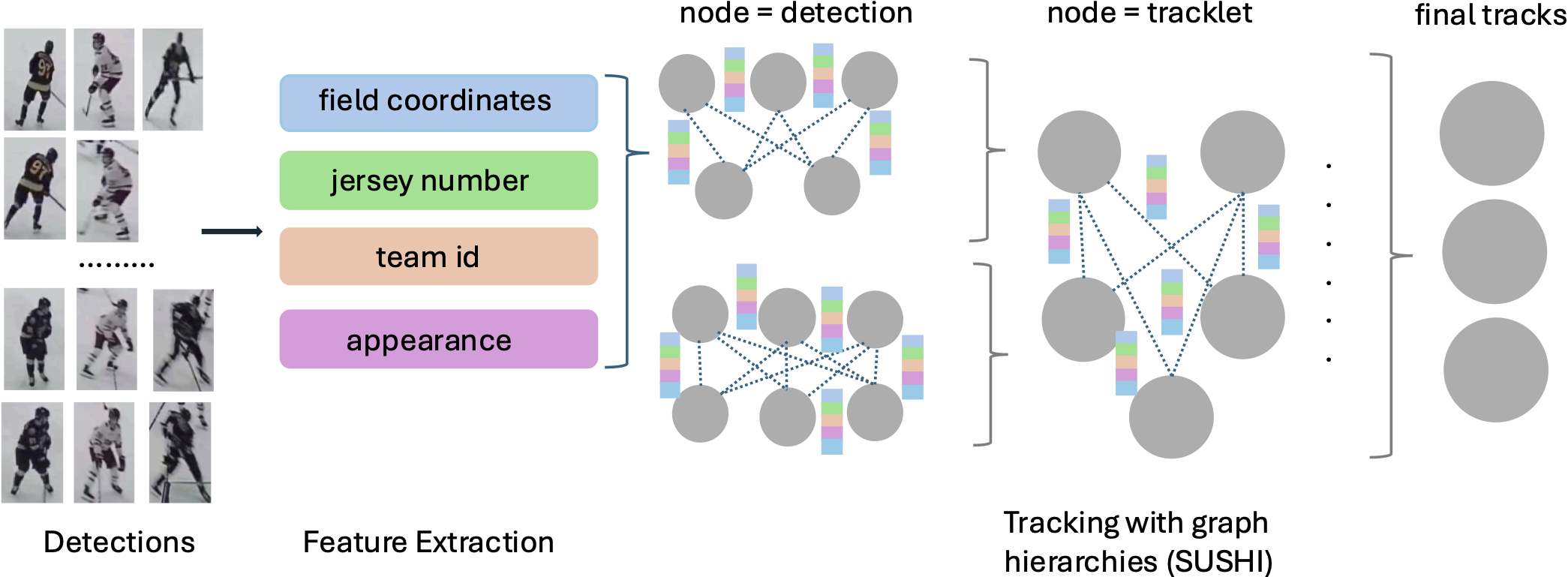Projects
Player Tracking
In team sports analytics long-term player tracking remains a challenging task due to player appearance similarity occlusion and dynamic motion patterns. Accurately re-identifying players and reconnecting tracklets after extended absences from the field of view or prolonged occlusions is crucial for robust analysis. We introduce SportsSUSHI a hierarchical graph-based approach that leverages domain-specific features including jersey numbers team IDs and field coordinates to enhance tracking accuracy. SportsSUSHI achieves high performance on the SoccerNet dataset and a newly proposed hockey tracking dataset.

Maria Koshkina, James H. Elder. “Towards long-term player tracking with graph hierarchies and domain-specific features” in WACV 2025 Computer Vision for Winter Sports Workshop. (Project GitHub).
Jersey Number Recognition
Jersey number recognition is a key task in sports video analysis, due in part to its importance for long-term player tracking. Unfortunately, each player’s jersey number is only visible in a fraction of video frames. Jersey number recognition can be viewed as a variant of scene text recognition. We introduce a general framework for jersey number recognition that builds on top of scene text recognition methods. We address issues of occlusions and assess the degree to which training on one sport (hockey) can be generalized to another (soccer). For the latter, we also consider how jersey number recognition at the single-image level can be aggregated across frames to yield tracklet-level jersey number labels. We demonstrate high performance on image- and tracklet-level tasks, achieving 91.4% accuracy for hockey images and 87.4% for soccer tracklets.

Maria Koshkina, James H. Elder A General Framework for Jersey Number Recognition in Sports Video, CVSports Workshop, CVPR 2024. Code is available here.
Unsupervised Player Classification
We address the problem of unsupervised classification of players in a team sport according to their team affiliation when jersey colours and design are not known a priori. We adopt a contrastive learning approach in which an embedding network learns to maximize the distance between representations of players on different teams relative to players on the same team, in a purely unsupervised fashion, without any labelled data. We evaluate the approach using a new hockey dataset and find that it outperforms prior unsupervised approaches by a substantial margin, particularly for real-time applications when only a small number of frames are available for unsupervised learning before team assignments must be made. Remarkably, we show that our contrastive method achieves 94% accuracy after unsupervised training on only a single frame, with accuracy rising to 97% within 500 frames (17 seconds of game time). We further demonstrate how accurate team classification allows accurate team-conditional heat maps of player positioning to be computed.

Maria Koshkina, Hemanth Pidaparthy, James H. Elder Contrastive Learning for Sports Video: Unsupervised Player Classification (2021), In Proceedings of the IEEE/CVF Conference on Computer Vision and Pattern Recognition (CVPR) Workshops, 4528-4536.
For more info see our project page and code.
